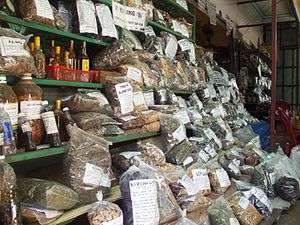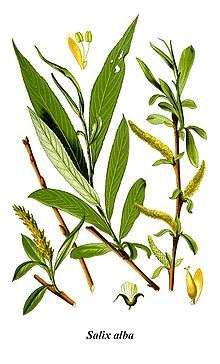Traditional Vietnamese medicine
Traditional Vietnamese medicine (Y học Cổ truyền Việt Nam), also known as Southern Herbology (Thuốc Nam) is a traditional medicine practiced by Vietnamese people. It is influenced by traditional Chinese medicine. The other traditional medicine that is also practiced in Vietnam is traditional Chinese medicine (Trung Y), also known as Northern Herbology (Thuốc Bắc).[1][2] Thuốc Nam is one of two kinds of folk remedies known to villagers, the other being the traditional exercise dưỡng sinh.[3][4]

Defining principles
Traditional Vietnamese medicine differs from traditional Chinese medicine in which it relies wholly on native ingredients which are then used in their fresh state or simply dried. Vietnamese medicine typically does not require complicated decoction seen in Chinese medicine.[5]
Even common herbs and vegetables like rau răm, kinh giới, cải cúc, rau muống[6] are used.[7] The flowers of Magnolia champaca, Jasminum sambac are also employed for their pharmacologic properties. Animal products like silkworms are infrequently used.[8]
In addition to ingested preparations, ointments and poultice are also part of the repertoire, along with steaming therapy (xông hơi).
Textual records
Various compendiums and treatises on traditional Vietnamese medicine include the 11-volume Nam dược thần hiệu by the 14th century physician Tuệ Tĩnh[9] and Hải Thượng y tông tâm lĩnh by the 18th century physician Hải Thượng Lãn Ông. Other pre-20th century texts include Nam dược chỉ danh truyền, Tiểu nhi khoa diễn Quốc âm.[10]
Application
Thuốc Nam is usually sought for more common ailments like coughs and fevers. Smallpox, a common occurrence in traditional Vietnam, also has a number of prescriptions in historic texts.[10]
See also
References
- Jan Van Alphen, Anthony Aris Oriental Medicine: An Illustrated Guide to the Asian Arts of Healing 1995 - Page 211 "Its influence on the cultural and medical traditions of Vietnam can be clearly seen in, for example, the classical distinction between Thuoc nam, 'Southern medicine', and Thuoc bac, 'Northern or Chinese Medicine'. Both were practised and ..."
- David Craig Familiar Medicine: Everyday Health Knowledge and Practice in Today's Vietnam. 2002 - Page 49 "In practice, fairly similar recipes are applied to a multitude of diseases: a "truly miraculous" medicine (thuoc than hieu) will cure "a ... Nam. WHILE Northern medicine refers to a high (Chinese) metropolitan tradition. Southern medicine has ...a double life, referring both to professional practice (transmitted within medical families and medical schools) and to the ... Southern medicine has been an affordable choice, with a straightforward curative (as opposed to a tonic) focus: as the"
- Philip Taylor Modernity and Re-Enchantment: Religion in Post-Revolutionary Vietnam 2007 - Page 99 "There are two kinds of folk medicine known to villagers; one is related to herbal medicine, and the other to a traditional martial art dưỡng sinh. Core elements of local indigenous folk medicine, or “y học bản địa,” include knowledge about... Most people in Đại Yên, regardless of age, gender or background, had some knowledge about how to grow and use thuốc nam."
- Tine Gammeltoft Women's Bodies Women's Worries 2012 -"People usually distinguish between 'Western medicine'(thuốc Tây) and 'Eastern medicine' (thuốcYorthuốc ta, 'our medicine'). There are two kinds of 'Eastern medicine'; thuốc Nam (Southern medicine), the indigenous Vietnamese medicine ..."
- Đông y Việt Nam
- Rau muống: một vị thuốc Nam thuần túy Archived 2009-07-12 at the Wayback Machine
- Mai Hoa. Chữa bệnh bằng cây thuốc Nam. Hà Nội: Văn hóa Thông tin, 2006.
- "Nam dược thần hiệu"
- Chữ Nôm trong kho thư tịch y dược

